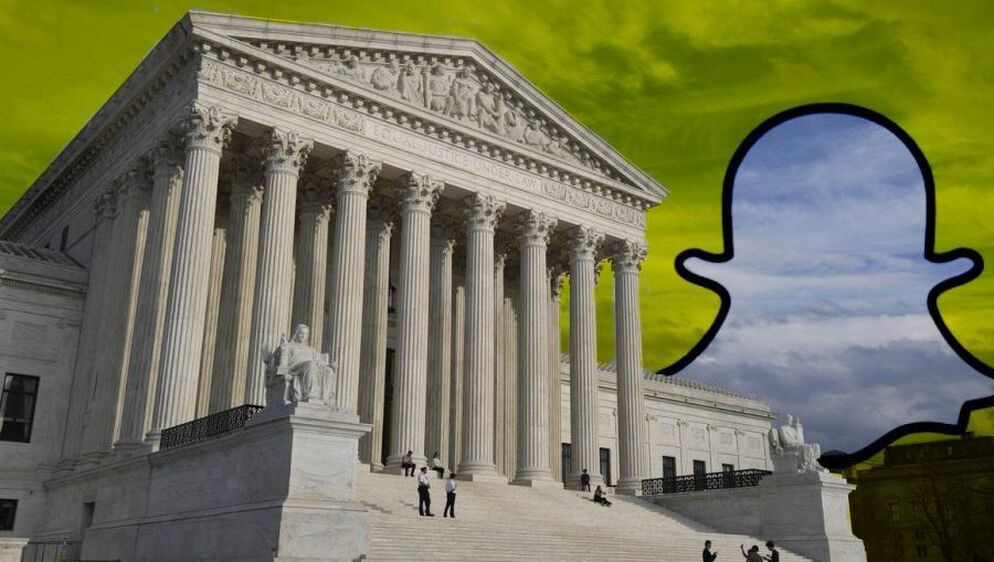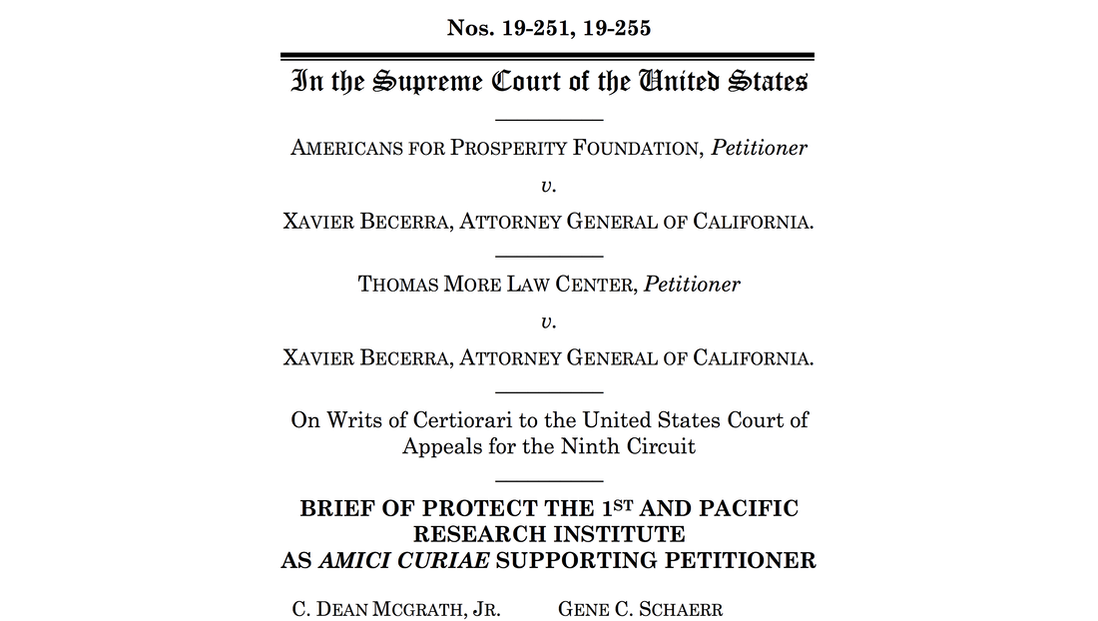|
Becket Fund's video shows in terms both stark and touching what is at stake for the Apache people in the Oak Flat decision.
The Supreme Court heard oral argument yesterday in Mahanoy Area School District v. B.L., a case asking whether public school officials can regulate their students’ off-campus speech. The case arose after a cheerleader one Saturday posted a Snapchat message with a picture of her and her friend raising their middle fingers captioned, “F*** school f*** softball f*** cheer f*** everything.” For this, she was removed from the cheerleading team for the year.
This isn’t the first time the Supreme Court has addressed students’ rights. In Tinker v. Des Moines Independent Community School District it held that, although students have First Amendment rights, schools can punish on-campus speech that “substantially interfere[s] with the work of the school.” In today’s case, the school board argued that Tinker should extend to off-campus speech because “students’ ubiquitous access to the Internet and social media have blurred any on-campus/off-campus distinction.” The justices recognized that this is a difficult question, but ultimately seem likely to side with the cheerleader. Some justices suggested that even if Tinker applied off campus, the cheerleader’s conduct didn’t meet its standard:
Justice Barrett seemed to side fully with the cheerleader. She instructed Lisa Blatt, the school district’s attorney, to “assume … that high school students enjoy the same free speech rights as everyone else,” and told Blatt there was not a “lot of doctrinal support for saying that Tinker applies” off campus. Other justices seemed unfriendly to the cheerleader’s position. Justice Thomas agreed that “if it’s on social media, where you post it … doesn’t really matter.” These posts, he recognized, could happen anywhere: “[H]ow would that make any difference, where you post it?” Chief Justice John Roberts likewise expressed skepticism of the cheerleader’s position. He wondered whether her argument means that, “no matter how disruptive a particular speech activity off campus … is to the school, it has no choice but to tolerate that because it can’t take any action against the student.” This case could go one of several ways. Tinker could apply generally, but not allow the school to punish the cheerleader’s conduct. Alternatively, it could apply both generally and allow the school to punish the cheerleader for her post. The most speech-protective option, and the outcome Protect The 1st endorses, would be a holding that Tinker does not apply off campus, and that off-campus speech is fully protected by the First Amendment. Unfortunately, because of the justice’s divergent questions, the oral argument left more questions than it answered. Protect The 1st hopes the Court recognizes that the state’s power to control speech faces full First Amendment protection outside the schoolhouse gate. We expect an opinion in June and will report back then. The Supreme Court heard oral argument today in Americans for Prosperity v. Rodriquez. The case asks whether California can, consistent with the First Amendment, require all charities doing business in the state to disclose to the state Attorney General a list of their donors. Protect The First (PT1st), together with the Pacific Research Institute, filed a brief earlier this year that argued that the California requirement violates the First Amendment by chilling the speech of would-be donors.
The justices’ questions suggest the Supreme Court understands and agrees with PT1st’s brief. Justices Sotomayor and Kagan both seemed to agree that California violated—at the very least—the First Amendment rights of the petitioners challenging the law. Sotomayor, for example, recognized that it was “without dispute … that a disclosure of their donors would harm them.” Sotomayor then echoed one of the central themes of PT1st’s brief: Even though California promises to keep the disclosed information private, there is a “human fear” that such information, which is uploaded to an online database, will be hacked. Justice Kagan, for her part, emphasized the district court’s findings that California had (1) a history of inadvertent disclosure and (2) that petitioner’s donors would face threats and harassment if their affiliations were disclosed. Because such findings are reviewed for clear error, a very deferential standard, Justice Kagan had no choice but to ask, “How can you win on the as-applied challenge?” In other words, doesn’t the history and facts of this case render it constitutionally suspect, at least in respect to the petitioners? It is hard to imagine a question that serves as a better tell for how a justice is approaching a case. Other justices seemed likely to go even further and find that the California disclosure regime is facially unconstitutional, meaning that it violates the First Amendment in any context:
It is never wise to bet on how the Court will decide a case. But the justices’ questions suggest the Court will likely find the California scheme unconstitutional, at least as applied to the petitioners, because of the risk of threats and harassment that they proved at trial. That itself would be a win. The questions of multiple justices, however, suggest that the Court might go further and provide relief to all charities by finding the law unconstitutional on its face. PT1st remains hopeful the Court will provide an opinion that either expressly or implicitly invalidates California’s scheme. We expect an opinion in late June, and will report back then. Why would a U.S. sailor contest an order to shave off his beard?
When it is “a religious requirement and an expression of obedience and fidelity to God,” according to the testimony of Electrician’s Mate (Nuclear) 3rd Class Edmund Di Liscia, a Hasidic Jew aboard the aircraft carrier Theodore Roosevelt, now on duty in the Pacific. Di Liscia had obtained a religious accommodation to wear his beard while in uniform. When his ship’s command overruled that accommodation, Di Liscia obtained a court order from a federal judge for a temporary stay. The sailor submitted testimony saying the order to shave was “extremely humiliating and deeply jarring to my psyche and soul.” The Becket Fund for Religious Liberty, which supports the rights of service personnel to observe their religion, argued that the order is a violation of the Religious Freedom Restoration Act. Becket is also representing Mass Communications Specialist 3rd Class Leo Katsareas, a devout Muslim who wishes to retain his beard while serving in the U.S. Navy. Safeguarding the free exercise of religion for military personnel is a key concern of Protect The 1st. We believe that Americans of many faiths, from Muslim women seeking to wear a hijab, to Sikhs who want to wear a kirpan (a small, ceremonial sword) or a kara (religious bracelet), to members of other faiths – all have shown they can both be true to their religion and serve our country with honor and distinction. When the U.S. Chamber of Commerce and the American Civil Liberties Union both warn of severe unintended consequences of a legislative provision, perhaps it is time to hit the ‘pause’ button.
The Chamber took a broad position against H.R. 1, which passed the House on a party-line vote and is now before the Senate. Among the many reasons the Chamber opposes this bill is its impact on political speech and donor privacy. “H.R. 1 would also usher in a host of onerous disclaimer requirements for those engaging in communications that mention a candidate or elected official, even if those communications are related to legislative issues.” The ACLU supports many of the provisions of H.R. 1, but spells out why the donor disclosure provision is so problematic. Writing in The Washington Post, ACLU senior legislative counsel Kate Ruane, wrote: “We know from history that people engaged in politically charged issues become political targets and are often subject to threats of harassment or even violence. This should be gravely concerning in light of the rise in white supremacist violence that has brazenly targeted private citizens and public officials alike. Moreover, in the time of social media, there is heightened interest in who is supporting these efforts.” Conservatives and liberals can disagree over the merits of H.R.1’s many provisions. But civil libertarians of all stripes see a danger when donors are exposed to doxing by the government, and the abuse, threats and intimidation that can result from that. Americans for Prosperity Foundation v. Rodriguez asks the Supreme Court whether California can require charitable non-profits to disclose their donors before operating in California.
Protect The 1st and The Pacific Research Institute recently filed an amicus brief in this case. There, we demonstrated that the same right of confidentiality that the Supreme Court recognized in NAACP v. Alabama (1958) should apply to donors of all groups, equally. Eight organizations have since filed amicus briefs supporting California’s regulation. Most of them are a variation on a theme: When it comes to the exposure and harassment of donors, there’s nothing to see here, folks, so move along now. A group of legal historians, for example, filed a brief arguing that the record here “does not contain the overwhelming evidence mustered in the civil rights-era cases that providing list of members would likely lead to public disclosures and to real physical harm.” Another brief from a coalition of U.S. senators argues that “[t]here is simply no comparison between the violent oppression faced by individual members of groups supporting racial justice in the South in the Jim Crow 1950s and the lofty power enjoyed by the country’s secretive donor elite today.” Briefs filed by other groups attempted to undermine the risks to privacy by arguing that, even though there were some lapses in confidentiality, they have been resolved. To them, the risk of harm is, at best, “speculative.” These groups miss the point, and are wrong in any event. Examples from California itself show that the fears would-be donors have about donating are not speculative, but are instead logical responses to real harms. In 2009, for example, the California attorney general’s office mislabeled contributions and released them on the internet, including the confidential information of hundreds of donors to Planned Parenthood. “California data security is demonstrably weak and hackable,” says Gene Schaerr, general counsel of Protect The 1st. “But even if donor identification is never revealed, a chilling effect still occurs when this information is available to powerful and ambitious politicians. Just the knowledge that a donor’s name may be misused – publicly exposed in a hack, or privately in a disclosure to a politician or regulator – would be enough to stifle speech.” He continued, “These briefs are right to assert that there is no comparison between a donor to the NAACP in the Jim Crow era and a donor today. But one doesn’t have to face the worst possible threat to be intimidated. There has been no shortage of recent examples of people being threatened in our era of ‘cancel culture’ and ‘doxing.’” Schaerr cites a list of recent “doxing” incidents in which the combination of a donor’s name and address, when combined with location devices and data from social media, led to harassment of donors, from abortion providers, to opponents of same sex marriage, to members of Black Lives Matter. “Donors don’t have to face the same level of intimidation as the members of the NAACP to be scared away from exercising their core First Amendment rights,” Schaerr said. “With all of the risks that come with donor disclosure, there is ample reason to apply NAACP’s rule in this context, and thereby protect the First Amendment freedoms of association and speech from burdensome disclosure requirements.” |
Archives
June 2024
Categories
All
|
ABOUT |
ISSUES |
TAKE ACTION |





 RSS Feed
RSS Feed